13. Eruptions at Rabaul: 1994–1999
Many of our old folk (our patuana) knew that an eruption was imminent. The strength of the earthquakes told them that an eruption was only a matter of days or hours away … . But the government authorities had not said anything about an eruption … . The Volcanological Observatory, as we have always been told, has some of the most modern and sophisticated monitoring equipment which can predict an eruption to the minute. How come these machines have not said anything about an imminent eruption?
Derol Ereman, a Boisen High School student from Matupit Island (quoted by Neumann, 1995, pp. 2–3).
First Three Weeks
Independence Day celebrations for the 19th national birthday of Papua New Guinea were interrupted by earthquake activity over the weekend in Rabaul beginning at 2.50–2.51 am on Sunday 18 September 1994. Two earthquakes about 40 seconds apart — one near Tavurvur the other near Vulcan — were felt strongly throughout the harbour area. Aftershocks and ground shaking continued, particularly in the Vulcan area. Rabaul Volcanological Observatory (RVO) volcanologists suspected, for about 12 hours, that the earthquake activity represented another ‘seismic swarm’, similar to many of those experienced in Rabaul during the 1970s and 1980s. The ground shaking continued and, by Sunday afternoon, villagers near Tavurvur on Matupit Island had begun a spontaneous evacuation into Rabaul town, encouraged by older people who recalled the 1937 volcanic eruption. Hundreds of other Matupits, however, remained on their threatened island.1
The number of people moving along the road grew, fed by other nearby communities, and by evening thousands of evacuees had gathered at floodlit Queen Elizabeth Park, an evacuation assembly point prescribed in the Rabaul Disaster Plan. Vehicles organised by the Provincial Disaster Committee (PDC), plus many that were provided by local businesses or hot-wired and taken from, for example, the closed transport pool of the Department of Works, began transporting evacuees out of Rabaul. Traffic streamed out of the caldera particularly over Tunnel Hill. The PDC, on RVO’s recommendation, declared a Stage 2 alert at 6.15 pm, which was announced to the general community on the provincial radio station. Looting, mainly by men and youths, began that night in Rabaul as vehicles coming into town were loaded up with alcohol, television sets, VCRs, food, and whatever else could be taken from the abandoned homes and businesses. Vandalism followed, as well as later scavenging of building materials.
RVO volcanologists during the night of 18–19 September became convinced that a volcanic eruption would take place. They recommended to the PDC that a Stage 3 alert be announced, signifying that an eruption was likely to take place within days to weeks, but a decision was made to postpone any such declaration until daybreak, given that the spontaneous evacuation was already underway and proceeding, if not in perfect orderly fashion, then at least without any noticeable mass panic. The National Disaster Emergency Services (NDES) in Port Moresby, however, was informed from Rabaul that an eruption was thought to be imminent, and its director, Leith Anderson, that night passed on this information to other parts of the government — including Prime Minister Sir Julius Chan — as well as to aviation authorities and to the media, which began broadcasting the news nationwide including in Rabaul. Meanwhile, spontaneous evacuation of villages near Vulcan, such as Tavana and Valaur, was taking place, especially after about 1.00 am on Monday 19 September, when escaping aircraft could be heard taking off from the Lakunai Airport in the clear moonlight. People knew that such aircraft movement was unusual because the airstrip had no runway lights for approved night-time departures or landings.
The provincial radio station in Rabaul had closed during the night and did not resume service until early next morning, after which the same Stage 2 announcement continued to be broadcast, including the advice that people need not evacuate. RVO volcanologists by this time — at dawn — were convinced, belatedly, that an eruption could be expected immediately because they could see from Observatory Ridge that sea floor on the eastern side of Vulcan had risen several metres out of the water, as it had in the hours before the eruption in 1937. The south-eastern end of Matupit Island had risen too. Then, at 6.06 am, only 27 hours after the two felt earthquakes, Tavurvur volcano began issuing vapour and ash, its first eruption in 51 years. Voluminous damp ash in dense dark-grey clouds began to be driven by the strong, and strongly directional, south-east trade winds over the eastern part of Rabaul town, enveloping it in darkness. Rain turned the ash to mud.
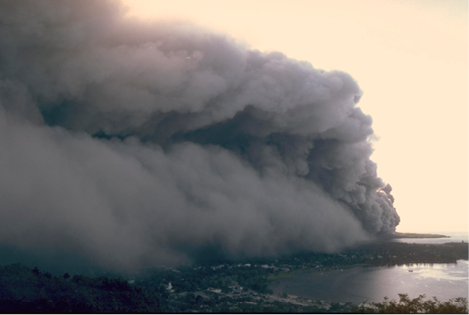
Figure 104. Ash clouds from Tavurvur volcano spread across the eastern part of Rabaul town on 19 September 1994, as seen here from Observatory Ridge at 7.30 am. The lower of the two layers of cloud represents an earlier phase of the eruption.
Source: Lauer. (1995, p. 15). CPD Resources, Queensland (Img0051). Digitally enhanced copy provided by N. Lauer, Brisbane.
Vulcan broke out in eruption at 7.17 am, first as surtseyan activity at the waters’ edge but soon also from further vents upslope on the volcano, from which pyroclastic flows spilled across part of the harbour. Strong jetting and plinian activity next developed at Vulcan, the column entraining sea water and reaching heights of at least 20 kilometres, well into the stratosphere. The clouds from Tavurvur, in contrast, mostly rose no more than about six kilometres. Vulcan continued to issue pyroclastic flows and surges, and tsunamis from the Vulcan activity washed up along the harbour shoreline causing damage — to houses on Matupit Island for example. Rabaul Harbour became clogged with floating pumice which was trapped there by the south-east winds for many weeks. The simultaneous eruptive activity from the two volcanoes in the south-east season of 1994 was therefore similar to the 1937 Rabaul eruption, except that Vulcan was the first to become active in 1937. Furthermore, the damage inflicted on Rabaul Town in 1994 was much greater than in 1937.
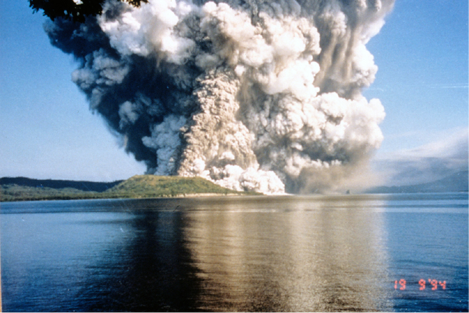
Figure 105. Vulcan is seen from the south jetting pumice, ash, and water vapour out from an inclined vent at shortly after 7.30 am on 19 September 1994. Pyroclastic flows are moving to the north-east across the waters of Rabaul Harbour. The water surface in the foreground is calm but would soon become more disturbed after the pyroclastic flows began crashing down onto the water, generating volcanic tsunamis.
Source: M. Phillips, B. Alexander and S. McGrade, Rabaul.
Early evacuation of people and communities to safer places meant that few were caught out in the areas of serious volcanic fallout — particularly in abandoned Rabaul town — and none were overwhelmed by the Vulcan pyroclastic flows. Numerous places of assembly became hastily erected camps throughout the north-eastern Gazelle Peninsula in patterns not matching those set out in the formal disaster plan. The camps became ‘care centres’ ranging in size from large formal ones — as in the case of the Kokopo Showground, Vunapope Mission, and at Kerevat — to small spontaneous encampments at or near the unaffected homes of friends and wantoks in hamlets, villages, or in Kokopo itself, for example. Others stayed at schools, churches, missions, and community centres. Many families and villages were split between different care centres in the chaos of the evacuations. More than 100,000 people are thought to have been affected by the eruption and many had to be accommodated in the care centres and their needs attended to by the authorities.
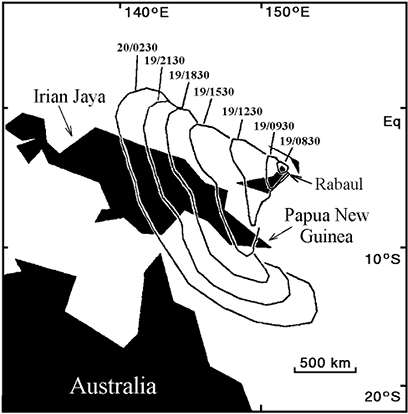
Figure 106. The westward progress of the Vulcan eruption cloud was tracked by the US National Ocean and Atmosphere Administration using satellite imagery. ‘19/0830’ refers to 8.30 am on 19 September 1994, and so on. Tracking clouds in this way assists aviation authorities. There were no encounters between international jets and the drifting ash clouds from Rabaul in 1994, but airline companies sustained additional fuel costs because of aircraft diversions on longer routes.
Source: McKee et al. (1994, Figure 4). The map was supplied by J. Lynch, National Ocean and Atmosphere Administration.
Stage 3 and 4 alerts were declared officially, but redundantly, after the start of the Tavurvur eruption, and a massive national response was initiated, supported by resources from many international agencies, including churches and non-governmental organisations. The Australian military began using a C130 Hercules aircraft to fly in relief supplies to Tokua Airport and to take out evacuees to Port Moresby, as did other flights. Many other evacuees left for other parts of Papua New Guinea by sea. Anderson, of NDES, had been appointed Controller of the relief effort almost immediately, but the PNG military took charge a few days later after the national executive council rescinded Anderson’s appointment. ‘Operation Unity’ was initiated, its name evidently carrying a signal from the national government in relation to recent discussions concerning secession by the Islands Region from the rest of Papua New Guinea. Brigadier General Rochus I. Lokinap was the new Controller. His command structure of four senior men included deputy controller Ellison Kaivovo, Secretary of the Department of East New Britain and chairman of the PDC. A disaster control centre was established at the Ralum Golf Club on the western outskirts of Kokopo, near the decaying stone steps of Queen Emma’s old mansion overlooking St Georges Channel. Access to destroyed Rabaul town was restricted by a checkpoint manned by police and military at the foot of Tunnel Hill. The general public, including former town residents, had to obtain passes before entry was permitted.
The Rabaul eruption received widespread attention from both national and international media, and accuracy and appropriateness in the newspaper coverage were mixed. International television coverage was immediate. I was in the United Kingdom visiting my father in the third week of September when we saw the spectacular images from Rabaul on BBC television, the first indication for me that the long-expected eruption had finally taken place.

Figure 107. Eruption clouds from both Vulcan and Tavurvur were photographed on 19 September 1994 by astronauts at the International Space Station. The larger, higher, Vulcan cloud is seen spreading fan-like westwards across the Bismarck Sea. The lower and less pronounced cloud from Tavurvur — indicated by the two arrows — extends north-westwards.
Source: Smithsonian GVN Bulletin (August 1994, Figure 4). US National Aeronautics and Space Administration (STS064-116-64).
Physical Damage
Several of us were invited to Rabaul to assist with the ongoing assessment of the eruption and disaster. I arrived there on Friday 7 October, nearly three weeks after the catastrophe. Hugh Davies, now Professor of Geology at the University of Papua New Guinea, was already in Rabaul as the assigned volcanological liaison officer, a position he had also held during the 1983–1985 seismo-deformational crisis. Davies met me at Tokua Airport and we travelled by helicopter to the busy disaster control centre at Raluan, and then over devastated Rabaul town to RVO headquarters on Observatory Ridge. Tavurvur was still in mild eruption, but the volcanic activity at Vulcan had ceased on 2 October and had greatly diminished even by 24 September. Russell Blong was in Rabaul town, toiling in the dusty and deserted streets collecting building damage data for his PNG insurance-industry sponsors.2 Furthermore, a Volcanic Disaster Assistance Program (VDAP) team of three from the United States Geological Survey (USGS) was based at RVO headquarters. VDAP-USGS had accepted a formal request from the Government of Papua New Guinea for assistance in re-establishing the instrumental monitoring network at Rabaul, which had been largely lost as a result of ash damage, looting and tsunamis. Other arrivals had been self-motivated and curious university researchers, including most notably, the well-known American volcanologist Stanley N. Williams and one of his PhD students.
Chris McKee and I drove down Tunnel Hill Road from RVO that Friday afternoon, passing through the army checkpoint at the foot of the hill, and then east along Malaguna Road where the ash-fall damage to buildings and the wharf was not severe. Ash thickness increased substantially, however, beyond St Francis Xavier Cathedral and then, turning right into Mango Avenue, the full extent of the town’s devastation could be appreciated. McKee was still as deeply affected after several visits to Mango Avenue as I was shocked by my first close-up sight of the ash-mantled buildings and roads where, formerly, there had been a thriving business district and town life. Many roofs had collapsed in the days after the initial eruption at Tavurvur on 19 September, but not those, for example, of the Hamamas Hotel whose owners, the McGrade family, had promptly removed ash from the hotel’s roofs and gutters. The roads were eerily deserted and silent, the ash deadening the sounds of tyres on what had been humming tarmac. Cross-cutting streets had been bulldozed down to the harbour’s edge in order to make channels for floods and mudflows from the walls of the caldera that were now stripped of vegetation. Powerlines were down. Rainfall gullying had destroyed the road up Namanula Hill, which previously had linked the town with the villages on the St Georges Channel coast to the east. The north-coast road at Vuvu and parts of the Kokopo Road had also been cut by torrential flooding following the Vulcan eruption.
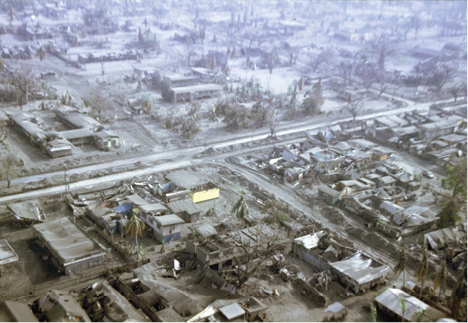
Figure 108. The extent of damage to buildings in the northern part of Rabaul town is seen in this aerial view in October 1994. Roofs of many ash-covered buildings in the foreground have collapsed or buckled. Trees have been stripped of foliage, including those that once shaded the central strip of Malaguna Road. By this time graders had cleared roadways and streets, leaving ash piled in ridges on either side of their tracks.
Source: R.W. Johnson. Geoscience Australia (no registered number).
Houses in Malaytown and Rapindik, south of the main Rabaul business district, were the worst affected, partially buried by about 1.5 metres of ash. Prime Minister Chan’s nearby home was badly damaged too, as were the buildings, airstrip and the few remaining fixed-wing aircraft and helicopters at Lakunai Airport. McKee and I, that same evening, used flashlights to visit his looted and deserted home at the top of Tunnel Hill Road. Personal possessions, including those of his two young daughters, had been trashed underfoot repeatedly, by what seems to have been dozens of looters who had trampled indiscriminately through the clothes and mementos of a family’s life. I saw in later days that damage in the ash-desert area around and to the north-west of Vulcan, was also severe. The villages of Valaur and Tavana, for example, were buried, including the Tavana memorial to those killed by the 1937 eruption — as well as the memorial’s now ash-interred words, ‘The earth buried them’. Several metres of ash deposition here had buried several kilometres of the sealed Kokopo–Rabaul trunk road, and vehicles had to negotiate an unsealed and dusty track that had been hurriedly re-engineered to reconnect the two towns.
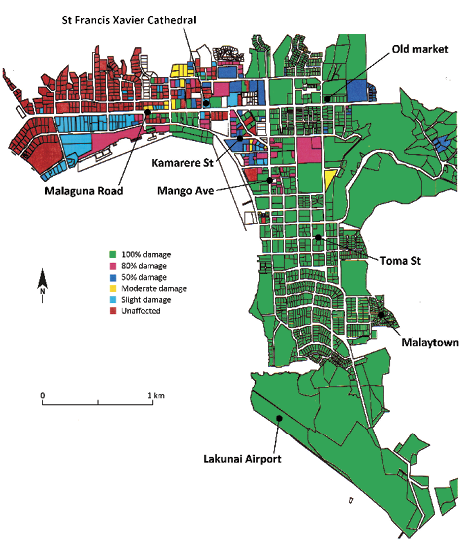
Figure 109. Officers of the East New Britain Provincial Administration produced this map of relative ash damage in Rabaul town. Blong & McKee (1995, Figure 13) published a version of it, but questioned the definition of six different categories used for the damage assessment. The main features of the damage are, however, clear: maximum damage in the east as far south as the airport, and very little damage on either side of Malaguna Road in the west, including the wharfs area.
Source: Adapted from Lokinap (1995, front-cover illustration).
How much direct volcanic damage had been inflicted on the physical investment in the north-eastern Gazelle region? An Australian International Development Assistance Agency (AIDAB) mission estimated infrastructure losses to government-owned assets to be about 100 million PNG kina, but together with private-sector losses — which were more difficult to estimate — the total may have been of the order of 300 million.3 The damage from the ash falls was therefore significant. Nevertheless, Blong and McKee reported that
there can be no doubt that looters trashed the town. One insurer estimated that two-thirds of the eruption-related claims under the company’s policies were for looting … . Many buildings were looted many times. Contents that were not stolen were often vandalised, strewn around, trampled in the ash and mud, or abandoned in the streets as the loot became too heavy … . Many who lost possessions believe that the looting was well organised … . [It] continued for weeks.4
Only four people lost their lives from the ash falls in Rabaul, plus one other killed by a lightning strike south of Vulcan. This is a remarkably low death toll, bearing in mind the potential for a much higher number had an evacuation not taken place in time. The toll is low, too, compared to the almost 3,000 people who were killed by the Lamington eruption of 1951 and to the 500 deaths in the Vulcan area in 1937. The Rabaul eruption of 1994, however, destroyed much more property and infrastructure and therefore cost more in financial terms.
The ravaged Mango Avenue and Malaytown sectors of Rabaul town were virtually unrepairable and therefore untenable. Decisions on the future now had to be made at all levels of society: individuals, families, villages, communities, businesses, churches, non-governmental organisations and the national and provincial governments. The Provincial Government’s headquarters in Rabaul had been destroyed, and the Administration moved temporarily to Vunadadir, west of Kokopo. Indeed, a general population shift to the Kokopo area as the main regional centre, and to settlements farther away, was virtually unstoppable, even as some politicians and business people argued for the rebuilding of Rabaul. Grief and nostalgia for ‘old Rabaul’ was widespread and palpable.5 Much of western Malaguna Road, however, had received only light ash falls, the nearby wharfs were still operable, and three hotels were still operating on Mango Avenue. Parts of the town would therefore survive. The disaster relief phase ended during the first months of 1995 and some relative normality returned when Operation Unity ceased, care centres were closed, schools reopened, people moved to resettlement areas or returned to those villages that could rebuilt, and local agricultural products began to be exported again from the wharfs.
Post Mortem and New Directions for RVO
Many expatriate or foreign professionals — as individuals or in partnerships — assessed the 1994 disaster at Rabaul and derived lessons learnt for disaster management, social and environmental recovery, regional development, and business and private insurance in the few years following the disaster. In addition, as provincial Secretary, Kaivovo conceived the idea of a collection and assessment of perceptions, experiences and opinions from the Gazelle communities who had been so seriously affected by the eruptions. Dr Klaus Neumann, a Kuanua-speaking Pacific historian of German origin, followed up on this proposal, visiting the Rabaul area, interviewing hundreds of people, and drawing on more than 2,000 written contributions by community and high-school students in East New Britain.6
Two of the several recurrent themes in these written reviews are, firstly, the remarkably effective and ‘spontaneous’ evacuation of the communities before the eruptions began, and second, an antithesis — the intensity and longevity of the looting. One view is that the successful self-evacuation represents a volcano-respecting community of people who had learnt lessons from the government-sponsored hazard-awareness raising activities during the 1980s. An alternative view, however, is that the communities were so resilient, strong and intrinsically intelligent that the evacuation would have taken place anyway, without any organised approach to awareness-raising from authorities who, in the end, had failed to provide adequate warnings of the impending eruption. There was indeed a sense that significant parts of the Tolai communities did not have great respect, variru, for the authorities who, rather, were perceived as being ineffective and secretive, if not weak and condescending. The European, Chinese and other Papua New Guinean parts of Rabaul society responded differently to the dominant Tolai sector, and indeed received different degrees of attention from the authorities. The most vulnerable and least resilient were probably Papuan New Guineans from other parts of the country — called vaira by the Tolai. Some of them were squatters. Some were the ‘children of Rabaul’ — those born in Rabaul of non-Tolai, or only one Tolai, parents.7
Many people were surprised and shocked by the extent and intensity of the looting. Others, of a more pragmatic and realistic persuasion, were not. Even undamaged government buildings, including Nonga Hospital and community schools, were targeted, but not, significantly, the churches. One view is that looting is a normal aspect of any disaster anywhere in the world and that nothing special should be interpreted from it in the case of Rabaul. Indeed, many communities worldwide are, in different degrees, potentially fractious, in part reflecting systemic issues of cohesion and discontent. These issues may, therefore, at times of disaster, lead to a sudden breakdown of law and order and therefore to opportunities for looting, unless well-resourced police and military interventions are implemented quickly and effectively and vigilance is maintained. This assumes of course that police and military personel themselves do not take part in the looting. Breakdown in communication infrastructure, such as takes place in any society impacted by a major disaster, is also a contributing factor.
A full analysis of the motivation for the looting has not been made in the case of the Rabaul volcanic disaster of 1994. Could the looting have been mitigated by allowing townspeople to return immediately to their properties and so protect their assets from looters? Can the repeated trashing of the town and other facilities be taken as a sign of community frustration at the government agencies? There were also, however, signs of increased crime in the Rabaul area even before the eruption. Did, therefore, unemployment, limited access to material wealth and disaffection in the villages represent an opportunity for strong criminal elements to manipulate a situation for their own ends as the disaster unfolded? Both community resilience and a decision-making independence from government authority were therefore demonstrated in 1994. The impressive and life-saving spontaneous evacuation of a resilient people, and the criminal opportunism if not anarchistic overtones of those involved in the long-lasting and vehement looting may, in fact, have been grounded in a similar lack of regard and trust for government authorities, including advisers such as the RVO.
The feeling amongst the RVO volcanologists was that they had let the community down, a conclusion that was confirmed by the bluntness of some of Neumann’s words:
The RVO and PDC were both accused of not having alerted people in time. It had been widely believed that the RVO would be able to forecast an eruption several days, if not weeks, in advance. The belief had not been publicly discredited by the RVO … . [Furthermore, the] widely known incident of people from Valaur visiting RVO on Sunday morning [18 September 1994] only to be told not to worry has often been cited to me by Tolai villagers as a particularly telling example of the ignorance of the scientists at the RVO … . [The] PDC is also accused of being responsible for broadcasting the message that people should not panic and stay at home on Sunday night and early Monday morning … at a time when Tavurvur was already visibly emitting ash is often quoted as evidence for the alleged incompetence of members of the PDC.8
Some in the community were even more cynical. The crisis in 1983–1985 had been a waste of money; the RVO was wrong in its forecasts then, so why should it be expected to get it right in 1994?9 Warnings had not, indeed, been issued sufficiently early by RVO and the PDC in order to permit businesses and householders to remove belongings and goods, store them safely, secure abandoned buildings, remove perishables from refrigerators, and so on — and then to evacuate safely. A period of less than 27 hours was far too short. Even an earlier announcement of a Stage 4 alert — say, at dawn on the Sunday morning, 24 hours before the start of the eruption — could not have provided the much longer preparation period required. RVO had been in a hopeless situation.
RVO staff were interviewed by many visitors after the disaster and were disarmingly open and honest about their role during the nightmare events of 18–19 September that had enveloped them so rapidly. They had, as scientists, been caught during the critical 27-hour period in part by the desire to base a final decision on Stage 4 on the best possible factual evidence. This understandable caution was in striking contrast to the attitudes of the communities themselves who were quite willing to sacrifice the need for caution, precision, and certainty for a timely decision to self-evacuate.
RVO acknowledged that there was a need for change to their modus operandi. Six main strategic issues can be identified:10
- 1. The first, and perhaps most obvious, issue was that the four-stage alert scheme was inadequate. Its main weaknesses had in fact been noted during the 1983–1985 seismic crisis — that RVO may well have to raise the level of alert very quickly. This meant, for example, that pronouncement of a Stage 2 alert, signifying an eruption within weeks to months, might change to Stage 4 in a matter of hours — as happened in September 1994. But this implied, in turn, that RVO must have had inadequate or wrong information and understanding to announce the Stage 2 alert in the first place. A new alert scheme was needed, one that did not signify a definite timeframe of eruption expectancy.
- 2. PNG’s volcanological service had deteriorated over a period of several years after the 1983–1985 crisis. Even the long-established program of methodical temperature measurement at key locations in the harbour had ceased. Furthermore, staff levels had declined and instruments on high-risk volcanoes nationwide were in need of replacement. The Rabaul monitoring network in 1994 had been adequate for the general ‘research’ kind of approach that involves sufficient time for the slow, careful, and systematic analysis of data, but not for the immediate and stressful demands of short lead-up periods when real-time monitoring was essential.
- 3. Much more needed to be discovered about the caldera system at Rabaul in order to progress a fuller scientific understanding of how it actually operates. Questions included: What does the underground magmatic ‘plumbing’ at Rabaul look like? Can it be mapped? Would any forthcoming answers help in understanding where the magma resides, how much there is of it and, more particularly, what signals does the magma provide when it moves towards the surface?
- 4. RVO needed to have a better organised strategy for community engagement. Many individual scientists and technicians at RVO, such as Leslie Topue and Ben Talai, had for years been prepared as individuals to answer questions, and give talks, about volcanoes in general and RVO’s work in particular, to local groups and communities. There was now, however, the need for a whole-of-agency commitment to the broader area of volcanic-risk assessment and reduction, in partnership with at-risk communities themselves, rather than the work being focused mainly on instrumental monitoring, hazard mapping and research.
- 5. The RVO building was erected in 1940 on Observatory Ridge, largely because of the panoramic view that could be obtained of Rabaul Harbour and its active volcanoes, but that visibility was lost during the 1994 eruption by the enveloping ash clouds from Tavurvur and Vulcan. The question of the suitability of the Observatory Ridge site needed to be addressed, in an era when any loss of visual observation capacity can be compensated by more modern instrumental monitoring — including video cameras — based at a central observatory in a less vulnerable location.
- 6. The final issue involved the management of well-meaning, but uninvited, scientists — who arrive during volcanic crises for their own research purposes and who do not always contribute constructively to the priority needs of crisis management and effective liaison with the public, officials and media. This was dealt with internationally after the Rabaul 1994 eruption and after volcanic crises elsewhere.11
The Secretary of the Department of Mining, RVO’s host department in Port Moresby, announced in the second week of October 1994 that Talai would be taking over as head of RVO, the first Melanesian to do so. This represented a reversal of management roles between Papua New Guinean Talai and expatriate McKee, who later moved to Port Moresby and became head of the Geophysical Observatory there.
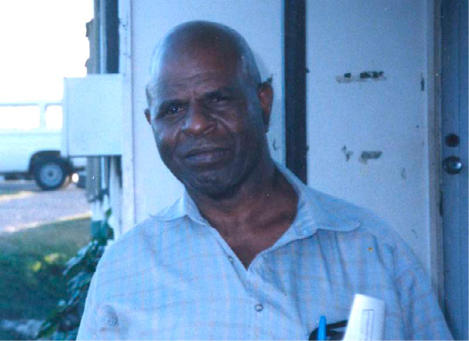
Figure 110. Ben Talai at the Rabaul Volcanological Observatory in about 1999.
Source: S.J. Saunders.
AIDAB completed its ‘Needs Assessment’ mission and, supported by the Papua New Guinea Government, followed up immediately on the first recommendation — to help strengthen Papua New Guinea’s national volcanological service centred on RVO as a matter of urgency. AIDAB, soon to become known as AusAID — the Australian Agency for International Development — then accepted a full project proposal that was prepared by several of us in RVO, AusAID, and the Australian Geological Survey Organisation — formerly BMR and now called Geoscience Australia. Thus began the ‘Papua New Guinea – Australia Volcanological Service Support Project’ (VSS Project), which ran under the joint guidance of Talai and myself from 1995 to 1999. The AusAID-funded VSS Project purchased new volcano-monitoring equipment for RVO, provided funds for community-awareness campaigns to be run by RVO throughout Papua New Guinea, and supported a major deep-crustal geophysical survey of the Blanche Bay caldera region.
Talai’s appointment as leader of RVO in October 1994 was a landmark event, but in 1999 at the age of only 51 — and having accumulated more than 25 years of volcanological experience — he left the organisation. Seismologist Ima Itikarai, from Central Province, who had joined RVO in 1984, took over as the new head of RVO.
Ongoing Eruptions and New Insights
Explosive eruptions continued at Tavurvur after the main eruptions of 19 September 1994. These explosions were of different strengths and were anything from minutes to several months apart, but their cumulative effect on the town of Rabaul was unrelenting, particularly during the dry season when the south-east trades blew yet more ash over the beleaguered town. Gas, vapour, and aerosol from Tavurvur, together with accompanying rain caused acid attack on metal surfaces, vegetation was prevented from rejuvenating, and some trees died altogether. The town at times seemed to regenerate and become greener, especially during the north-west monsoon when the ash from the volcano drifted south-eastwards, but the additional rainfall caused floods of mud and water from the caldera walls, which made roads and streets in the town and on the road to Kokopo impassable to traffic. Wharfs at Rabaul were still operating but siltation of shallow waters began to be a problem both there and in other parts of Blanche Bay. The ash drifted in a south-easterly direction during the north-west monsoons, which produced respite for Rabaul, but as a result the ash instead fell on the developing town of Kokopo and the airport at Tokua, which on occasions had to be closed to air traffic. Dried-out ash and dust in either season could be re-suspended on windy days, or lofted by fast traffic on unsealed roads, causing discomfort if not distress to those ingesting the contaminated air, particularly people already experiencing bronchial ailments.12 There was no indication, by the end of 1999, that the explosive eruptions from Tavurvur would stop.
Residents became familiar with the sudden explosive rise of ash clouds high above Tavurvur. RVO volcanologists recognised these, scientifically, as being mainly vulcanian, but there were times when the eruptions had a definite strombolian character. These were identifiable clearly after dark when incandescence in the crater was impressively vivid and the explosive eruptions included sprays of glowing blocks and lumps of lava that crashed onto the outer slopes causing broken blocks to cascade down towards the foot of the volcano. In particular, eight brief strombolian events were identified, interspersed with ‘normal’ vulcanian activity between May 1996 and 17 August 1997. Lava flows were produced on four of these occasions. This distinctive period of strombolian activity came to be known informally as ‘phase 2’ of the ongoing eruption.13
Staff at RVO, under Itikarai’s leadership, and others, began compiling data on the geophysical precursors to the 1994 eruption at Rabaul. These were used in conjunction with results of ongoing research and from the different surveys of Rabaul Caldera, eventually to reach an improved understanding of how eruptions take place at Rabaul. Itikarai illustrated the geophysical build-up from 1968 to the eruption in 1994 by plotting both the number of earthquakes recorded monthly at Rabaul and the amount of uplift at the southern end of Matupit Island, and by dividing 1968–1994 into five successive periods.14 The 1983–1985 seismic crisis, or Period 3, at Rabaul stands out prominently, providing the basic rationale for the view that an eruption was imminent at the time. No eruption took place, but note that uplift continued at Matupit Island after Period 3, together with smaller earthquake swarms, before the outbreak of the 1994 eruption. In retrospect, therefore, the caldera at Rabaul can be judged to have continued being active, and to be still inflating, after 1985.
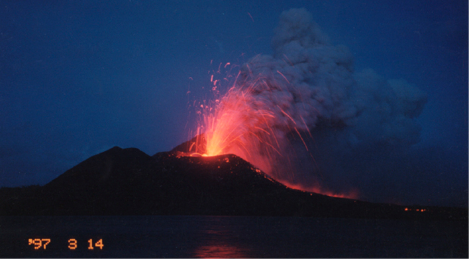
Figure 111. Strombolian eruption at Tavurvur volcano as seen from Kaputin Point, Matupit Island, on 14 March 1997. A new lava flow is moving down the southern slopes of the volcano.
Source: S.J. Saunders.
Another feature of the pre-eruption earthquakes that was noted, especially by Itikarai, was that not all of the earthquakes were in the ‘seismic annulus’ which had so characterised the earthquake pattern before the 1994 eruption. Some earthquakes between 1992 and 1994 — and probably before that, too — were in a zone trending roughly north-eastwards out of the caldera area. Furthermore, profound changes in the earthquake pattern took place in the years following the 1994 eruption. The seismic annulus virtually disappeared and more ‘north-east earthquakes’ began to be recorded, defining a zone trending into St Georges Channel during a time when eruptions were continuing at Tavurvur.
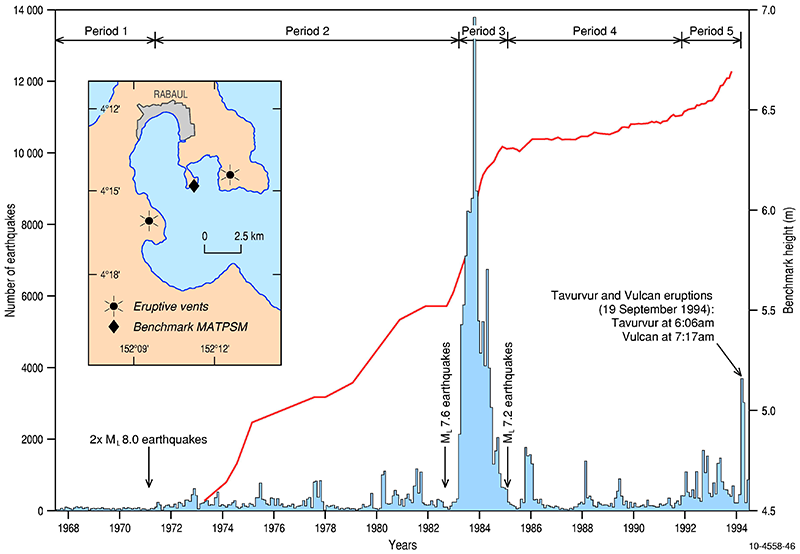
Figure 112. The numbers of earthquakes recorded each month at Rabaul between 1968 and 1994 are shown here in relation to five different periods (1–5) and to the progressive but irregular uplift (red line) at the southern end of Matupit Island.
Source: Itikarai (2008, adapted from Figure 2.9 by Johnson et al. 2010, Figure 46).
Several volcanologists, including myself, had from the beginning of the 1994 eruption been taking a special interest in the chemical composition and mineral content of the ashes and larger lava fragments being produced from Tavurvur and Vulcan.15 A conclusion, which soon became evident, was that the rocks being produced at both volcanoes did not represent a single type of homogeneous magma. Rather, they preserved a record of past ‘mixing’ or ‘mingling’ events at different times beneath the volcanoes between magmas of different compositions, and before eruptions took place. The rocks looked liked they carried mixed loads of crystals from different, old, magma batches, like a palimpsest manuscript. This was particularly evident in some Tavurvur samples in which, without the use of a magnifying glass or microscope, clusters of minerals could be identified that normally are found only in basalt. These minerals were much less common in Vulcan rocks. A ‘basaltic component’ was especially notable in phase 2 samples from Tavurvur. Yet, the overall compositions of the chemically analysed rock samples were those of andesite or dacite, magmas which are petrologically different from basalt. Scientific questions that arose included: Where does the basalt come from? Where does the magma mixing and mingling take place? Can magma chambers or reservoirs be identified beneath Rabaul? How do the magmas get to the surface?
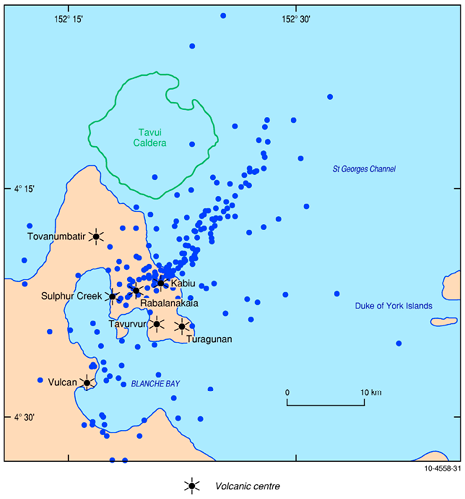
Figure 113. Earthquake epicentres for the period October 1994 to December 1998, showing the zone of earthquakes running north-eastwards from Rabaul into St Georges Channel.
Source: Itikarai (2008, adapted from Figure 5.10a by Johnson et al., 2010. Figure 31).
Possible answers to these questions began to emerge after a major, multi-agency, geophysical survey of the Rabaul Caldera was conducted involving the principles of ‘seismic tomography’, a technique rather analogous to the CAT-scan method used in investigative medicine. The deep structure of the Rabaul Caldera area was determined in three dimensions by mapping out the speeds with which seismic waves from both earthquakes and artificial explosions let off from a ship move through different parts of the Earth’s crust down to a depth of about 12 kilometres. This survey was regarded initially as a high-risk venture because scores of earthquake recorders had to be deployed throughout the Rabaul area for several months in 1997–1998. There were fears that the valuable equipment might be stolen or vandalised, bearing in mind the extensive looting that had taken place in 1994. The local communities, however, committed strongly to both the planning and execution of the fieldwork and the geophysical survey was completed successfully without significant incidents.
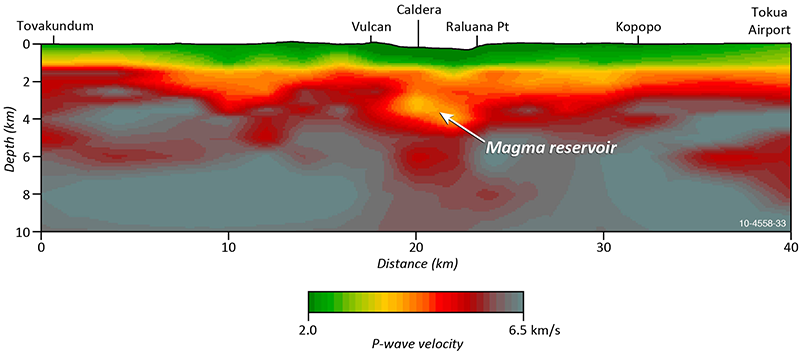
Figure 114. This diagram represents a vertical section through the Earth’s crust beneath the Rabaul area. The different colours represent materials that have different ‘seismic velocities’ — the speeds of earthquake waves as they pass through the crust — and which have been used to define a possible reservoir of magma deep beneath the caldera.
Source: Finlayson et al. (2003, adapted from Figure 9). Reproduced with the permission of Elsevier.
A major result of the survey was the detection of a three-to-six-kilometre-deep magma reservoir.16 The seismic velocities of the reservoir were sufficiently low that the presence of molten rock could be assumed. This is not to say that the entire reservoir contained only magmatic liquid — like an underground oil tank surrounded by rock. Rather, it was likely to be a mix or ‘mush’ of magma, crystals, and rock, its spatial limits being ill-defined. There would be further insights in later years when other scientists interpreted the data from the geophysical survey, when petrologists and geochemists obtained further analytical data, and when attempts were made to draw together all the known information on Rabaul volcano into a comprehensive interpretation of how the volcano might ‘work’.
Restoring the North-eastern Gazelle Peninsula
Shifting the socio-economic functions of Rabaul had been a dominant, but largely inconclusive, theme of discussion during the 1983–1985 seismo-deformational crisis. Construction of the Tokua Airstrip east of Kokopo on newly purchased land is, perhaps, the most outstanding example of post-crisis disaster preparation, undertaken in recognition of the prospect that Lakunai Airstrip, closer to Rabaul town, would not be operational during a volcanic eruption. Furthermore, in the decades before the 1983–1985 crisis, land had been purchased away from Rabaul as a consequence of land in or near Rabaul becoming more scarce for development. Redevelopment accelerated dramatically, however, after the 1994 disaster. Recovering from the 1994 eruption and reorganising the north-eastern Gazelle Peninsula as a whole, and the Kokopo area in particular, are post-disaster processes that continue today.17
A Gazelle Restoration Authority (GRA) was established in February 1995 and supported financially by several international development assistance agencies, perhaps most notably the World Bank, AusAID, and the Japan International Cooperation Agency (JICA). GRA was based in Port Moresby, close to central government, but an implementation unit was set up in Kokopo in May 1995 in order to oversee development and rebuilding of the north-eastern Gazelle region. Implementation of the Gazelle Restoration Program, under GRA, was planned in three stages, and the first or Immediate Term Restoration Program was scheduled to run from 1995 to 2000. The aims overall were to establish resettlement estates at Gelegela, Warena, Clifton and Sikut in the Warangoi Valley; to expand Kokopo town and develop nearby Kenebot as a new housing area, as well as Baliora as a satellite town; and to create a light industrial area at Takubar, eventually as part of a development ‘corridor’ towards Tokua Airport.
A further aim of the program was to upgrade existing transport infrastructure to cater for population shifts away from Rabaul to new areas. New roads were built in and around Kokopo and plantation land was bought by the Provincial Government for village settlements and services at Gelegela, Warena, Clifton and Sikut, which are all well south of the active caldera. They would be linked to the Kokopo area and the coast by an improved road network. Redevelopment in the following years and into the new millennium, however, did not go exactly to plan in these rural areas. Furthermore, not all of the new economic development arrangements were advantageous to the province. Introduction of the Organic Law on Provincial and Local Level Government meant that the budget available to the province after 1995 for maintenance of services, such as roads, would be provided through the national government rather than directly from provincial taxes.
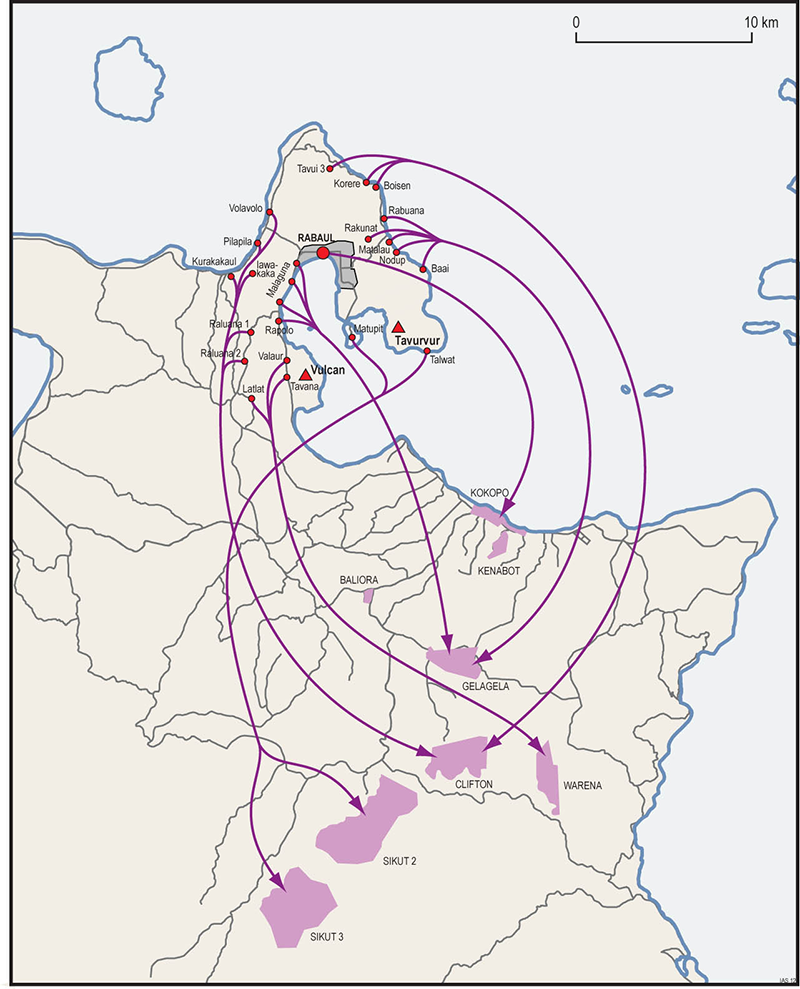
Figure 115. Populations in the Rabaul area after the 1994 eruption initially moved southwards to Kokopo and new settlements in the Warangoi Valley, as shown by the flow lines. Roads are shown in pale grey.
Source: Provided courtesy of I. Scales, who adapted this map from Figure 16 in his account (Scales, 2010).
The concept of urban safety is a relative concept and natural-hazard risk had not been eliminated by the new developments in the Kokopo area. Kokopo is built on the 1,400-year-old Rabaul ignimbrite — a reminder of past volcanic catastrophe and future possibilities. Much of old Kokopo is built on a terrace that sits several metres above sea level at high tide, but parts of the newly developed areas, especially coastal Takubar, are lower and exposed more directly to tsunamis in the Solomon Sea than is Kokopo itself. Furthermore, earthquake hazard at Kokopo was the main reason why N.H. Fisher did not favour the site for redevelopment immediately after the Second World War.18
Another early, and key, post-eruption decision was to develop a new land-use zoning scheme for Rabaul town itself. A steering committee was established under the umbrella of the East New Britain Provincial Physical Planning Board and, following extensive consultations with the community and the private sector, it released its development plan in August 1997. The long-term vision of the steering committee was ‘for a town more limited in extent than previously’.19 The declared starting point for the committee was equally pragmatic, direct, and logical: the port and wharf facilities at Rabaul were largely unaffected by the eruption; the harbour was the only deep, all-weather port in the New Guinea Islands region; the core of the province’s economy was port–related industry together with commercial ventures in Rabaul town; and, the validity of rebuilding Rabaul using public funds depended solely on the intentions of private firms to reinvest in property and to re-establish business.
The overwhelming response of Rabaul property and business owners at a public meeting held on 31 July 1997, was that they would not be deterred by the ongoing volcanic risk and that they wanted to start rebuilding Rabaul town without further delay, despite problems with obtaining comprehensive insurance cover. Thus, businesses that depended critically on the Rabaul wharfs did not move from the town area — for example, the large and largely undamaged coconut-oil refinery of Coconut Products Limited (CPL), at Toboi Wharf. Initial development of the town, however, would not extend south of Kamerere Street, which ran a few hundred metres south of and parallel to Malaguna Road, although power would be continued to two hotels and the Rabaul Yacht Club at the southern end of Mango Avenue. No development would take place south of Toma Street towards Tavurvur in the greatly devastated southern part of the old town, including Malaytown near Sulphur Creek. The vulnerable and unstable caldera wall area behind Rabaul town was declared a conservation area, which would be off limits to any development, and even to gardening.
The immediate development area would be the western part of the old town, the so-called ‘Sector 1’ area, running from Malaguna in the west, eastwards on either side of Malaguna Road, to Mango Avenue, thus excluding, for example, the Queen Elizabeth Park recreational area and the old market or bung. The market was renowned in the province as a magnet for commerce and social activity and, after the 1994 eruption, it had been re-established informally at Page Park at the opposite or western end of Malaguna Road. Support infrastructure was eventually provided for the market at the park, together with pick-up and set-down areas for public motor vehicles (PMV). The new market is near the foot of Tunnel Hill, meaning that people working and shopping there are in a far safer position for any required evacuation from the caldera, compared with the site of the old bung in the extreme east.
The 1994 volcanic eruption, therefore, reduced and redefined, but did not eliminate, Rabaul town. There has been, however, a momentous socio-economic shift away from what had been — starting in 1910 — the capital of German New Guinea, then the capital of the Australian-administered Territory of New Guinea between the two world wars and, finally, the capital of East New Britain Province after Papua New Guinea became an independent nation in 1975. Discussions on Rabaul’s relocation had started in 1937 when Dr W.G. Woolnough, in particular, recommended unequivocally that the government functions of the Territory capital at Rabaul be moved elsewhere. More specifically, Administrator J.K. Murray’s wish in the late 1940s — after the destruction of the town during the Second World War — to relocate the key functions of Rabaul town to Kokopo, had been fulfilled. Thus, Dr Albert Hahl’s original decision to move the old German capital from Kokopo to Rabaul in the first place was reversed in both a strategic and physical sense.
The narrative of the 1994 eruption, including its build-up from 1971 onwards as well as its impact on the people of East New Britain, did not by any means end as the twentieth century drew to a close. Other important eruptions and disasters had been taking place in Near Oceania, even though the events at Rabaul from 1994 to 1999 appear to dominate the history of the last decade of the century. There had also been profound technological and attitudinal changes in the world at large, which impacted on the direction taken by volcanic disaster risk reduction strategies in general in the region.
References
AIDAB, 1994. Rabaul Volcanic Disaster Needs Assessment Mission: Final Report. Australian International Development Assistance Bureau, Canberra.
Blong, R.J., 2003. ‘Building Damage in Rabaul, Papua New Guinea, 1994’, Bulletin of Volcanology, 65, pp. 43–54.
Blong, R.J. & C.O. McKee, 1995. The Rabaul Eruption 1994: Destruction of a Town. Natural Hazards Research Centre, Macquarie University, Sydney.
Davies, H., 1995a. The 1994 Eruption of Rabaul Volcano — A Case Study in Disaster Management. Report to United Nations Development Program, University of Papua New Guinea, Port Moresby.
——, 1995b. The 1994 Rabaul Eruption. Inaugural Professorial Lecture, University of Papua New Guinea.
Dent, A.W., G. Davies, P. Barrett & P.J.A. de Saint Ours, 1995. ‘The 1994 Eruption of the Rabaul Volcano, Papua New Guinea: Injuries Sustained and Medical Response’, Medical Journal of Australia, 163, pp. 635–39.
Durieux, J. & A. de Wildenberg, 1994. ‘Sous nos yeux, l’enfer a mis le feu au Paradis’, Figaro, 15 October, pp. 48–58.
East New Britain Provincial Planning Board, 1997. ‘Rabaul Subject (Zoning) Development Plan’. Rabaul Subject (Zoning) Development Plan Steering Committee, East New Britain Province.
Finlayson, D.M., O. Gudmundsson, I. Itikarai, Y. Nishimura & H. Shimamura, 2003. ‘Rabaul Volcano, Papua New Guinea: Seismic Tomographic Imaging of an Active Caldera’, Journal of Volcanology and Geothermal Research, 124, pp. 153–71.
Finnimore, E.T., B.S. Low, R.J. Martin, P. Karam, I.A. Nairn & B.J. Scott, 1995. Contingency Planning for and Emergency Management of the 1994 Rabaul Volcanic Eruption, Papua New Guinea. New Zealand Ministry of Civil Defence, Wellington.
Fisher, N.H., 1946. Administrative Centre for the Rabaul District. Department of Supply and Shipping, Mineral Resources Survey Branch Report 1946/32.
IAVCEI Subcommittee for Crisis Protocols, 1999. ‘Professional Conduct of Scientists During Volcanic Crises’, Bulletin of Volcanology, 60, pp. 323–34.
Itikarai, I., 2008. ‘The 3-D Structure and Earthquake Locations at Rabaul Caldera, Papua New Guinea’. Master of Philosophy thesis, The Australian National University, Canberra.
Johnson, R.W., I. Itikarai, H. Patia, & C.O. McKee, 2010. Volcanic Systems of the Northeastern Gazelle Peninsula, Papua New Guinea: Synopsis, Evaluation, and a Model for Rabaul Volcano. Rabaul Volcano Workshop Report. Papua New Guinea Department of Mineral Policy and Geohazards Management and the Australian Agency for International Development, Port Moresby.
Lauer, S., 1995. Pumice and Ash: An Account of the 1994 Rabaul Volcanic Eruptions. CPD Resources, Lismore.
Le Blond, J.S., C.J. Horwell, B.J. Williamson, S. Michnowicz, F. Kelly & P. Delmelle, 2008. Report on the Mineralogical and Geochemical Characterisation of Rabaul Ash for the Assessment of Respiratory Health Hazard, Department of Geography, University of Cambridge.
Lentfer, C., & B. Boyd, 2001. Maunten Paia: Volcanoes, People, and Environment: The 1994 Rabaul Volcanic Eruptions. Southern Cross University Press, Lismore.
Lindley, I.D., 1995. The 1994-1995 Rabaul Volcanic Eruptions: Human Aspects, Bulletin of the Royal Society of New South Wales, 188, pp. 7–9; 190, pp. 4–6.
Lokinap, R.I., 1994. Rabaul Volcanic Emergency: ‘Operation Unity’ Report to the National Parliament by the Controller (Report No 1). Government of Papua New Guinea, Port Moresby.
——, 1995. Rabaul Volcanic Emergency: ‘Operation Unity’ Report to the National Parliament by the Controller (Report No 4). Government of Papua New Guinea, Port Moresby.
McKee, C.O., 1999. ‘Lessons from Volcanic Crises and Eruptions at Rabaul’. Geological Survey of Papua New Guinea Report 99/17 (not yet released, assigned number only).
McKee, C.O., RVO Staff & R.W. Johnson, 1994. ‘Rabaul’, Global Volcanism Network Bulletin, 19, no. 9, pp. 4–7.
Nairn, I.A. & B.J. Scott, 1995. Scientific Management of the 1994 Rabaul Eruption: Lessons for New Zealand. Institute of Geological and Nuclear Sciences, New Zealand, Report 95/26.
Neumann, K., 1995. Tavurvur I Puongo!: Students’ Accounts of the 1994 Eruptions in East New Britain. Department of East New Britain, Vunadidir.
——, 1996a. Rabaul: Yu Swit Moa Yet: Surviving the 1994 Volcanic Eruption. Oxford University Press.
——, 1996b. The 1994 Volcanic Disaster in East New Britain and its Aftermath: Comments and Observations. Emergency Management Australia, Canberra, on behalf of the Australian International Decade for Natural Disaster Reduction Coordination Committee.
——, 1997. ‘Nostalgia for Rabaul’, Oceania, 67, pp. 177–93.
Patia, H., 2004. ‘Petrology and Geochemistry of the Recent Eruption History at Rabaul Caldera, Papua New Guinea: Implications for Magmatic Processes and Recurring Volcanic Activity’. Master of Philosophy thesis, The Australian National University, Canberra.
Rabaul Petrology Group, 1995. ‘Taking Petrologic Pathways toward Understanding Rabaul’s Restless Caldera’, Transactions of the American Geophysical Union, 76, no. 17, pp. 171, 180.
Roggensack, K., S.N. Williams, S.J. Schaefer, & R.A. Parnell Jr., 1996. ‘Volatiles from the 1994 Eruptions of Rabaul: Understanding Large Caldera Systems’, Science, 273, pp. 490–93.
Rose, W.I., D.J. Delene, D.J. Schneider, G.J.S. Bluth, A.J. Krueger, I. Sprod, C. McKee, H.L. Davies & G.G.J. Ernst, 1995. ‘Ice in the 1994 Rabaul Eruption Cloud: Implications for Volcano Hazard and Atmospheric Effects’, Nature, 375, pp. 477–79.
Scales, I., 2010. Roads in Gazelle Peninsula Development. Australian Agency for International Development, Canberra.
Smithsonian Institution, 1994. ‘Rabaul’, Global Volcanism Network Bulletin, 19, no. 8, pp. 2–6.
Tomblin, J., & J. Chung, 1995. Papua New Guinea Analysis of Lessons Learnt from Rabaul Volcanic Eruption and Programming for Disaster Mitigation Activities in Other Parts of the Country. United Nations Department of Humanitarian Affairs, Geneva.
Williams, S.N., 1996. ‘Double Trouble’, Earth: The Science of Our Planet, August, pp. 43–49.
World Publishing, 1994. Volcano. A Special Project of World Publishing Co Pty Ltd, Publishers of the Times of Papua New Guinea, Wantok, Weekend Sport, and PNG Business, Port Moresby.
1 Principal sources for both written and photographic information produced during the first three years following the Rabaul volcanic disaster of September 1994 include the following: AIDAB (1994), Durieux & de Wildenberg (1994), Smithsonian Institution (1994), Lokinap (1994, 1995), McKee et al. (1994), World Publishing (1994), Blong & McKee (1995), Davies (1995a, 1995b), Dent et al. (1995), Finnimore et al. (1995), Lauer (1995), Lindley (1995), Nairn & Scott (1995), Neumann (1995), Rabaul Petrology Group (1995), Rose et al. (1995), Tomblin & Chung (1995), Neumann (1996a, 1996b, 1997), Roggensack et al. (1996) and Williams (1996).
2 Blong (2003).
3 AIDAB (1994) and Blong & McKee (1995).
4 Blong & McKee (1995), p. 30.
5 Neumann (1997).
6 Neumann (1995, 1996a, 1996b, 1997).
7 See, especially, Neumann (1996a), chapter 31.
8 Neumann (1996b), p. 7.
9 K. Neumann (personal communication, 2008).
10 Lessons learnt from the 1994 eruption are discussed by McKee (1999) in an unpublished manuscript. Fourteen needs and six volcanological lessons were identified.
11 IAVCEI Subcommittee for Crisis Protocols (1999).
12 Dent et al. (1995). Longer term health aspects of the ongoing eruption at Rabaul are still being assessed. See for example, Le Blond et al. (2008).
13 Patia (2004).
14 Itikarai (2008). Note that these pre-1994 ‘periods’ are defined differently from ‘phase 2’ of the eruption itself, as identified by Patia (2004).
15 Rabaul Petrology Group (1995), Roggensack et al. (1996) and Patia (2004).
16 Finlayson et al. (2003).
17 Neumann (1996a), Lentfer & Boyd (2001) and Scales (2010).
18 Fisher (1946).
19 East New Britain Provincial Planning Board (1997).